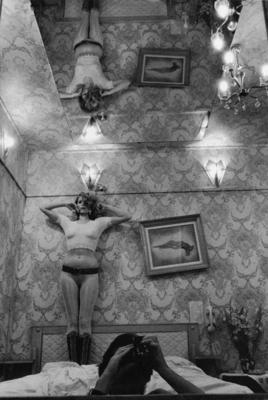 Pullens, Headlights Flare. Plexi Face Mount 2004.
Pullens, Headlights Flare. Plexi Face Mount 2004. Pullen, Red Stockings. C-Print, Plexi Face Mount 2005.
Pullen, Red Stockings. C-Print, Plexi Face Mount 2005. Pullen, Phones. C-Print, Plexi Face Mount 2005.
Pullen, Phones. C-Print, Plexi Face Mount 2005.Melanie Pullen's collection of more than one hundred photographs that comprise High Fashion Crime Scenes is based on vintage crime-scene images she mined from the files of the Los Angeles Police Department, the County Coroner's Office, and other primary sources. Drawn to the rich details and compelling stories preserved in the criminal records, she began re-enacting the crime-scenes, outfitting the "victims" (her selected models) in current haute couture, and photographing them in staged settings.
Pullen's images are repulsive and lovely all at once. Each scenario seems real as though one has seen it before whether they have or not. That they are in color heightens this sense of them being real. Yet, many have a staged quality that renders them false. Either way, they suggest strong narratives that are uncomfortable, eerie, and mysterious. As a viewer I want to know what happened to each of these women, I want to know the story, the history.








 Robert Gober, Untitled, 1990, from the Hirshhorn's collection.
Robert Gober, Untitled, 1990, from the Hirshhorn's collection.





 Savelev, Principe Pio Madrid. Multi layered pigment print on gesso layered aluminum, ed. of 3
Savelev, Principe Pio Madrid. Multi layered pigment print on gesso layered aluminum, ed. of 3

















 Jodie Lyn-
Jodie Lyn-